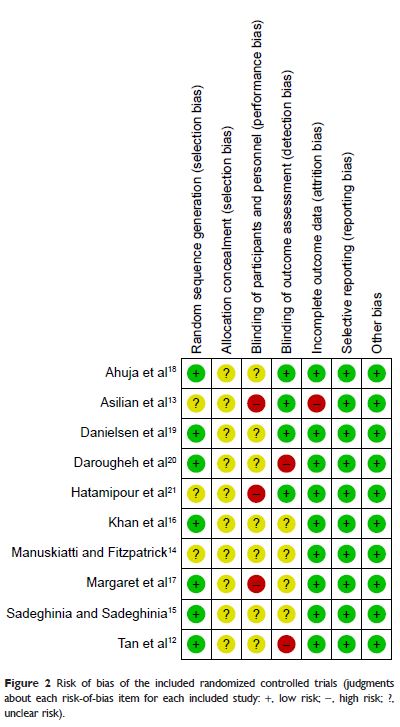108985
论文已发表
注册即可获取德孚的最新动态
IF 收录期刊
- 3.4 Breast Cancer (Dove Med Press)
- 3.2 Clin Epidemiol
- 2.6 Cancer Manag Res
- 2.9 Infect Drug Resist
- 3.7 Clin Interv Aging
- 5.1 Drug Des Dev Ther
- 3.1 Int J Chronic Obstr
- 6.6 Int J Nanomed
- 2.6 Int J Women's Health
- 2.9 Neuropsych Dis Treat
- 2.8 OncoTargets Ther
- 2.0 Patient Prefer Adher
- 2.2 Ther Clin Risk Manag
- 2.5 J Pain Res
- 3.0 Diabet Metab Synd Ob
- 3.2 Psychol Res Behav Ma
- 3.4 Nat Sci Sleep
- 1.8 Pharmgenomics Pers Med
- 2.0 Risk Manag Healthc Policy
- 4.1 J Inflamm Res
- 2.0 Int J Gen Med
- 3.4 J Hepatocell Carcinoma
- 3.0 J Asthma Allergy
- 2.2 Clin Cosmet Investig Dermatol
- 2.4 J Multidiscip Healthc

曲安奈德控制的瘢痕疙瘩治疗的常用疗法的效果和安全性:贝叶斯网络荟萃分析
Authors Zhang Z, Cheng L, Wang R, Cen Y, Li Z
Received 12 January 2018
Accepted for publication 7 March 2018
Published 29 May 2018 Volume 2018:14 Pages 973—980
DOI https://doi.org/10.2147/TCRM.S162315
Checked for plagiarism Yes
Review by Single-blind
Peer reviewers approved by Dr Cristina Weinberg
Peer reviewer comments 3
Editor who approved publication: Professor Deyun Wang
Background: Triamcinolone acetonide (TAC) is used frequently in the treatment
of keloid scars, but has presented controversial results. In this study, we aim
to evaluate the effectiveness of TAC compared with other common therapies used
in keloid treatment.
Methods: MEDLINE, Embase, Web of Science and the Cochrane Library databases
were searched until January 2018. Key data were extracted from eligible
randomized controlled trials. Both pairwise and network meta-analyses were
conducted for synthesizing data from eligible studies.
Results: Ten randomized controlled trials were included in this
meta-analysis. The relative risk of keloids associated with seven adjuvants was
analyzed, including placebo, pulsed dye laser (PDL), 5-fluorouracil (5-FU),
silicone, verapamil, TAC+5-FU and TAC+5-FU+PDL. Patients treated with the
following adjuvants appeared to not have significantly reduced risk of keloid
in relation to those treated with TAC: placebo (OR=1.86, 95% CI 1.12–2.61), PDL
(OR=1.32, 95% CI 0.53–3.30), 5-FU (OR=1.13, 95% CI 0.48–2.68), silicone (OR=1.28,
95% CI 0.59–2.78), verapamil (OR=1.86, 95% CI 0.67–5.14), TAC+5-FU (OR=0.77,
95% CI 0.38–1.58) and TAC+5-FU+PDL (OR=0.80, 95% CI 0.16–4.03). The surface
under the cumulative ranking curve values for each adjuvant were as follows:
TAC, 59.9%; placebo, 17.4%; PDL, 46.3%; 5-FU, 48.9%; silicone, 56.2%;
verapamil, 84.7%; TAC+5-FU, 68.5% and TAC+5-FU+PDL, 18.1%.
Conclusion: There were no differences between the efficacy of TAC and other
common therapies in keloid treatment. TAC also acts as an effective alternative
modality in the prevention and treatment of keloids. Incorporating adjuvants
particularly verapamil appeared to be significantly associated with a decreased
risk of keloids.
Keywords: keloid, triamcinolone acetonide, randomized controlled trial, network
meta-analysis
